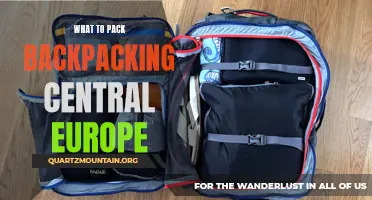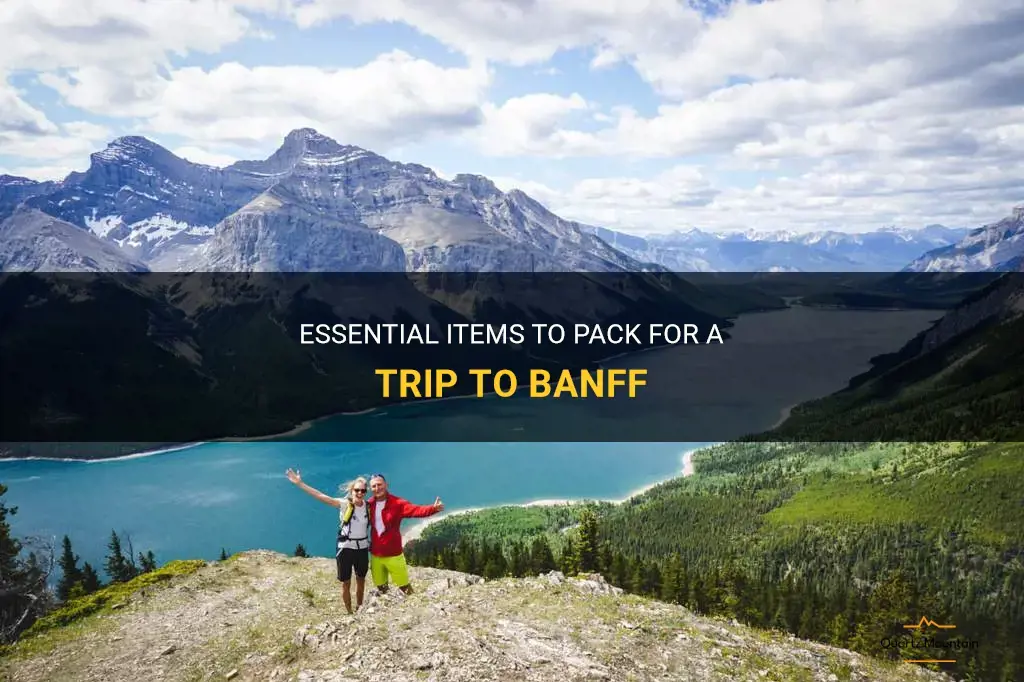
Planning a trip to Banff, the picturesque mountain town nestled in the heart of the Canadian Rockies? As you prepare to embark on your adventure, don't forget to pack these essential items to ensure a memorable and comfortable experience. Whether you're an avid hiker or a casual traveler, these must-haves will help you make the most of your time in Banff's natural wonders. So grab your backpack and get ready to explore this stunning destination like a pro!
What You'll Learn
- What are the essential items to pack for a trip to Banff?
- Are there any specific clothing or gear recommendations for activities in Banff?
- Are there any special considerations for packing for Banff's weather or climate?
- What should I pack for hiking or camping in Banff?
- Are there any restrictions or guidelines for packing certain items when traveling to Banff?

What are the essential items to pack for a trip to Banff?
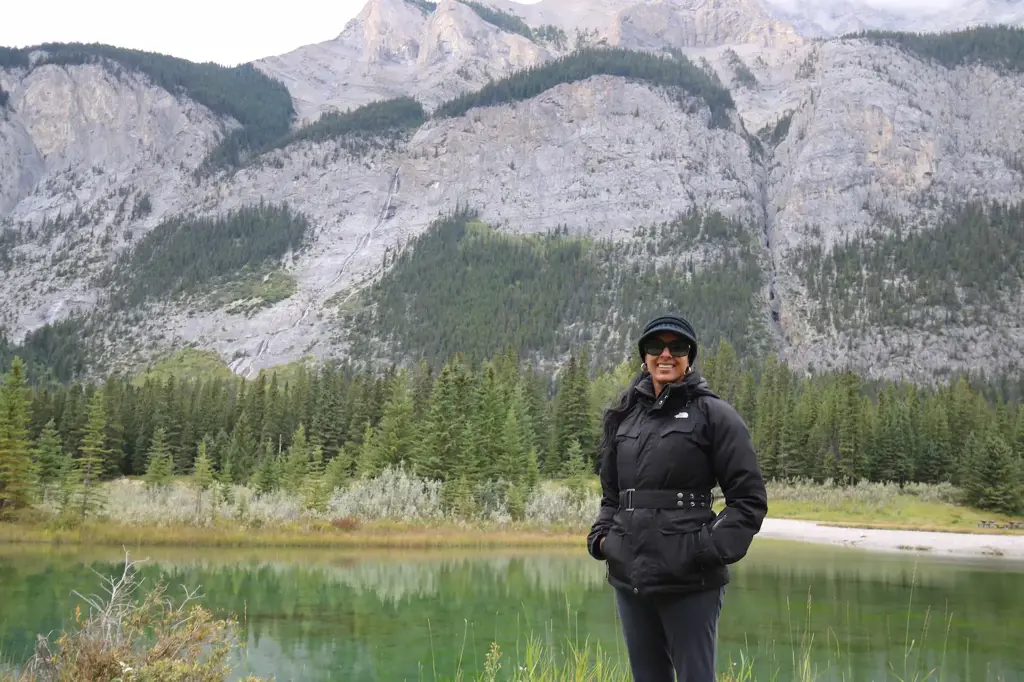
Planning a trip to Banff, Canada? Congratulations - you're in for a treat! Banff National Park is a stunning destination with a variety of activities and attractions to explore. To ensure you have an enjoyable and organized trip, it's important to pack the essential items. Here are some must-haves to consider for your visit to Banff.
- Clothing: The weather in Banff can vary greatly depending on the season, so it's important to pack accordingly. In the summer, lightweight and breathable clothing is essential. Don't forget to pack sunscreen, a hat, and sunglasses to protect yourself from the sun's rays. If you're visiting during the winter months, pack warm layers such as thermal underwear, wool socks, hats, gloves, and a good quality winter jacket to stay comfortable in the cold temperatures.
- Hiking gear: Banff is known for its breathtaking hiking trails, so make sure you come prepared. Invest in a comfortable pair of hiking boots with good ankle support, as the terrain can be rugged. Bring a sturdy backpack with plenty of water, snacks, and a map or GPS device. Additionally, consider packing items such as trekking poles, a headlamp, and a first aid kit for added safety.
- Camera: Banff is a photographer's paradise, so don't forget to pack your camera gear. Whether you prefer a DSLR, point-and-shoot, or even just your smartphone, make sure you have a way to capture those stunning landscapes and wildlife encounters. Don't forget spare batteries, memory cards, and a tripod for capturing those perfect shots.
- Binoculars: Banff is home to a diverse range of wildlife, including bears, elk, and bald eagles. To fully appreciate these magnificent creatures, pack a pair of binoculars. You'll have the opportunity to spot wildlife from a safe distance and get a closer look at their behavior and habitat.
- Water bottle and snacks: It's essential to stay hydrated and fueled during your adventures in Banff. Bring a reusable water bottle to fill up at various water stations throughout the park. Pack nutritious snacks such as trail mix, granola bars, and fresh fruit to keep your energy levels up during long hikes.
- Maps and guidebooks: While technology is helpful, it's always a good idea to have physical maps and guidebooks. These resources can provide valuable information on hiking trails, points of interest, and safety tips. Plus, they won't rely on cell service or battery life.
- Toiletries and personal care items: Don't forget the basics like toothbrush, toothpaste, shampoo, and soap. If you plan on camping or staying in accommodations without electricity, bring wet wipes for personal hygiene. It's also a good idea to pack any necessary medications, insect repellent, and a small first aid kit.
- Outdoor recreational equipment: If you plan on participating in activities such as canoeing, fishing, or biking, make sure to pack the necessary equipment. Check if the rental facilities are available in the area, and if not, pack your own gear to ensure you can enjoy these outdoor activities.
Remember, these are just some of the essential items to pack for your trip to Banff. Depending on your planned activities and personal preferences, you may need to add or subtract items from this list. With the right gear and preparation, you'll be ready to fully enjoy the beauty and adventure that Banff has to offer.
What Clothes Should I Pack for a Trip to Colombia?
You may want to see also

Are there any specific clothing or gear recommendations for activities in Banff?
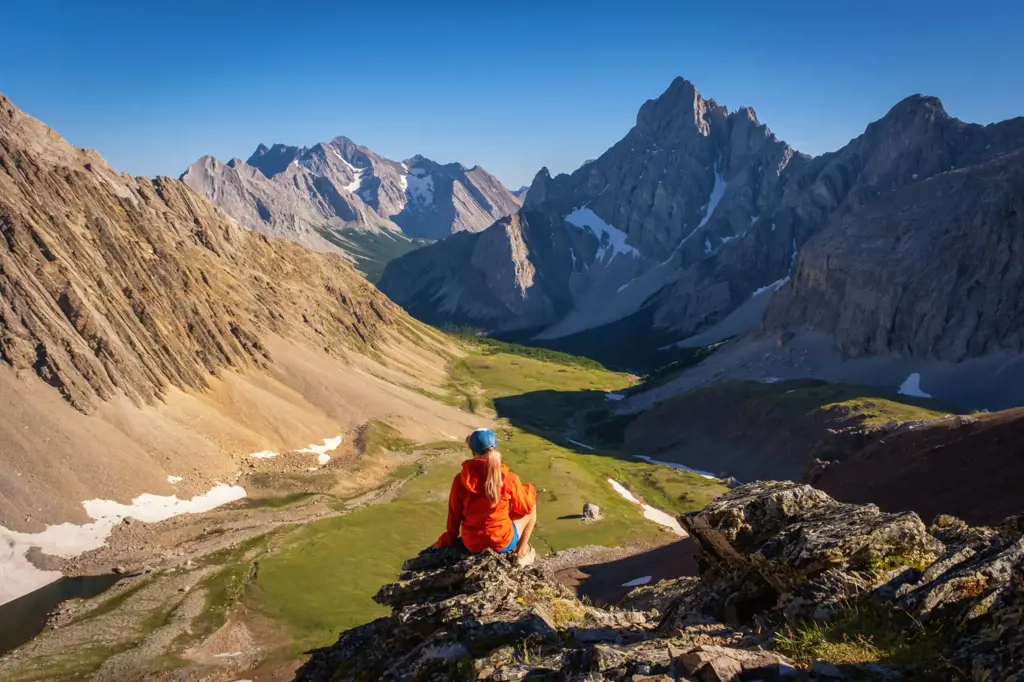
Banff National Park is a stunning outdoor playground in the Canadian Rockies, offering a wide range of activities for nature lovers and adventure enthusiasts. Whether you're planning to hike, ski, snowboard, or explore the beautiful landscapes, it's important to come well-prepared with the right clothing and gear.
Here are some specific recommendations for clothing and gear when visiting Banff:
- Layering is key: The weather in Banff can be unpredictable, especially in the mountains. It's essential to dress in layers, so you can adjust your clothing according to the temperature and activity level. Start with a moisture-wicking base layer that will keep you dry and comfortable, such as a synthetic or merino wool top and bottom.
- Insulating mid-layer: On top of your base layer, wear an insulating mid-layer, such as a fleece or down jacket. This layer will help trap heat and provide additional warmth during colder temperatures. Make sure it's easy to pack and lightweight, so you can easily carry it with you when hiking or skiing.
- Outer shell: A waterproof and breathable outer shell is crucial for protection against rain, snow, and wind. Look for a jacket and pants made from GORE-TEX or a similar material that offers both waterproofing and breathability. This will ensure you stay dry and comfortable throughout your outdoor activities.
- Hat, gloves, and neck gaiter: Headwear, gloves, and a neck gaiter or scarf are essential items to protect your extremities from the cold. Opt for items made from insulating and moisture-wicking materials, such as merino wool or synthetic fabrics. Don't forget to pack hand warmers if you're planning to spend long hours in the cold.
- Hiking boots: A comfortable pair of hiking boots is a must for exploring the trails in Banff. Look for boots with good ankle support, a durable and waterproof exterior, and a grippy sole for traction on various terrains. Break them in before your trip to avoid blisters and discomfort during long hikes.
- Trekking poles: If you're planning on hiking in Banff, consider using trekking poles for added stability and support. They can help reduce strain on your knees and provide stability on uneven terrain. Look for lightweight and adjustable poles that can be easily packed in your backpack when not in use.
- Backpack: A good backpack is essential for carrying all your gear and supplies during your outdoor adventures. Look for a backpack that is comfortable, has multiple compartments for easy organization, and is made from durable and water-resistant materials.
Examples of specific activities and the gear needed:
- Hiking: For day hikes, you'll need a comfortable backpack, a map, a compass, a water bottle, a first aid kit, and a headlamp. Don't forget to pack sunscreen, insect repellent, and a whistle for emergencies.
- Skiing/Snowboarding: If you're planning to hit the slopes, make sure to bring your ski/snowboard equipment, including skis/board, boots, bindings, helmet, goggles, and gloves. Consider layering up with thermal base layers and wearing waterproof ski/snowboard pants and jacket. Don't forget your ski pass and a map of the mountain.
- Wildlife viewing: Binoculars are a must if you want to spot wildlife from a distance. Bring a camera with a zoom lens to capture the beauty of the animals and the landscape. Consider wearing neutral-colored clothing to blend in with the surroundings and avoid disturbing the wildlife.
In summary, when visiting Banff National Park, it's important to dress appropriately for the weather and activities you plan to engage in. Layering your clothing, wearing waterproof outerwear, and packing essential gear will ensure you have a comfortable and enjoyable experience in this breathtaking Canadian wilderness.
Essential Items to Pack for a Memorable Vacation at Bald Head Island
You may want to see also

Are there any special considerations for packing for Banff's weather or climate?
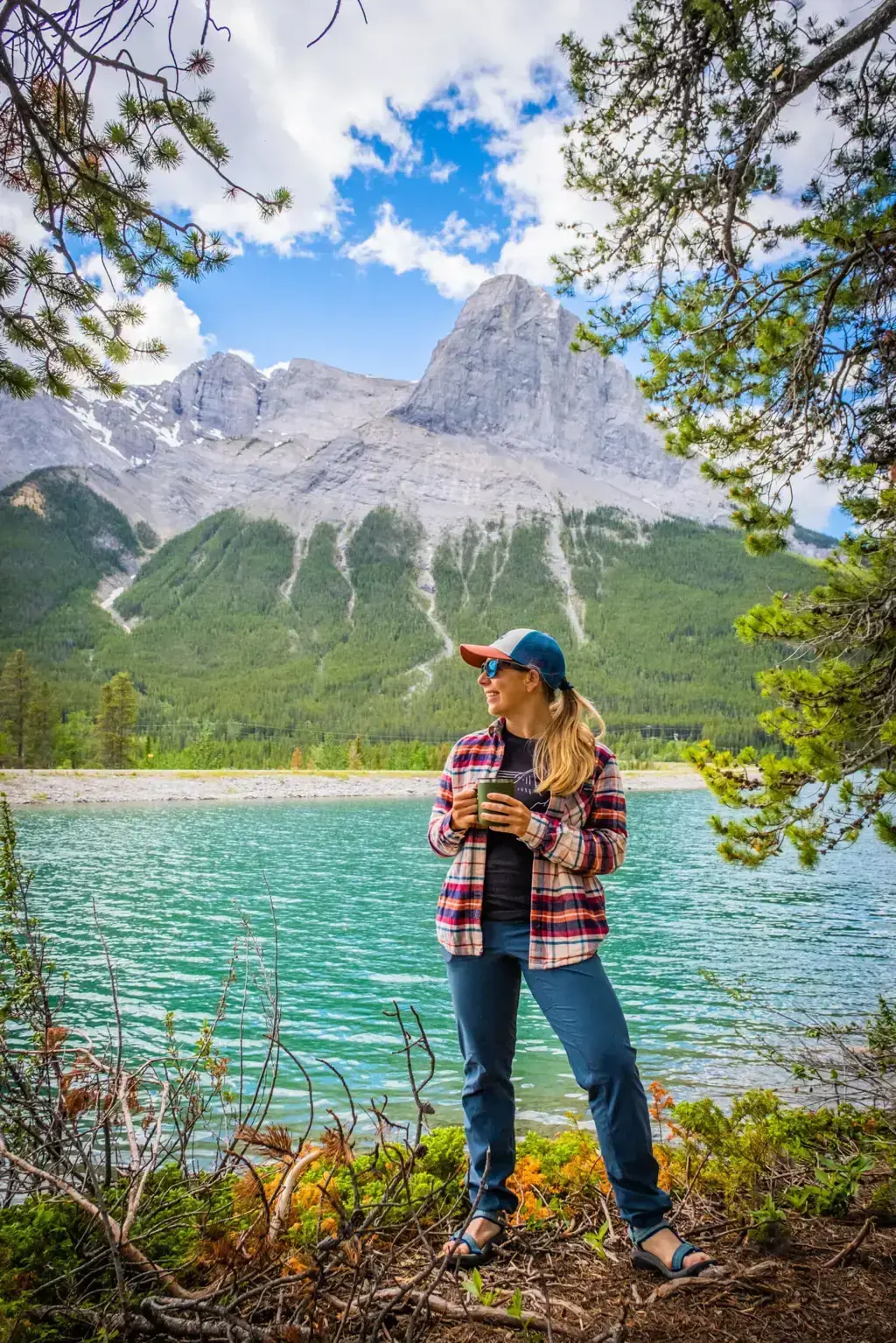
Banff National Park, located in Alberta, Canada, is known for its breathtaking natural beauty and diverse wildlife. The park attracts millions of visitors each year, who come to explore the stunning Rocky Mountains, glaciers, and pristine lakes. However, before embarking on your trip to Banff, it is important to pack accordingly to ensure you are prepared for the unique weather and climate of the region.
Banff's weather can be highly unpredictable, with rapid changes in temperature and sudden weather shifts. During the summer months, daytime temperatures can reach highs of 25°C (77°F), but can also drop to single digits at night. It is important to pack clothing that will keep you comfortable in both warm and cool conditions. Layering is key, as it allows you to easily adjust your clothing based on the changing temperatures throughout the day.
Here are some essential items to consider when packing for Banff:
- Waterproof Jacket: Banff experiences frequent rainfall, especially during the summer months. It is crucial to pack a good quality waterproof jacket to protect yourself from getting wet and cold during your outdoor adventures.
- Warm Layers: Even during the summer, evenings in Banff can get chilly. Be sure to pack a sweater or fleece jacket to keep you warm when the sun goes down.
- Hiking Boots: Banff is a haven for hiking enthusiasts, with an extensive network of trails to explore. Packing sturdy hiking boots with good traction is essential for tackling the rugged terrain and ensuring your feet stay comfortable and protected.
- Sun Protection: The sun's rays can be quite strong in the mountains, so packing sunscreen, a hat, and sunglasses is essential to protect your skin and eyes from harmful UV rays.
- Insect Repellent: Banff is home to various insects, including mosquitoes and black flies. Packing insect repellent will help keep these pesky bugs at bay and allow you to enjoy your outdoor activities without constant annoyance.
- Swimwear: Banff is famous for its stunning turquoise lakes, and you won't want to miss a chance to take a dip in their refreshing waters. Pack your swimwear so you can cool off during your hikes or relax at one of the many beautiful beaches.
- Camera: Banff is a photographer's dream, with endless opportunities for capturing awe-inspiring landscapes and wildlife. Don't forget to pack your camera or smartphone to document your adventures and create lasting memories.
Before your trip, it is advisable to check the weather forecast for Banff to ensure you are adequately prepared. It is also worth noting that Banff's weather can be highly changeable, so even if the forecast predicts clear skies, it is always a good idea to pack a rain jacket and other essential items.
By considering these special packing considerations for Banff's weather and climate, you will be ready to fully enjoy all that this remarkable national park has to offer. Whether you are hiking, camping, or simply soaking in the natural beauty, being prepared for the elements will ensure a memorable and comfortable visit to Banff.
The Best Supplies for Safely Packing Dishes
You may want to see also

What should I pack for hiking or camping in Banff?
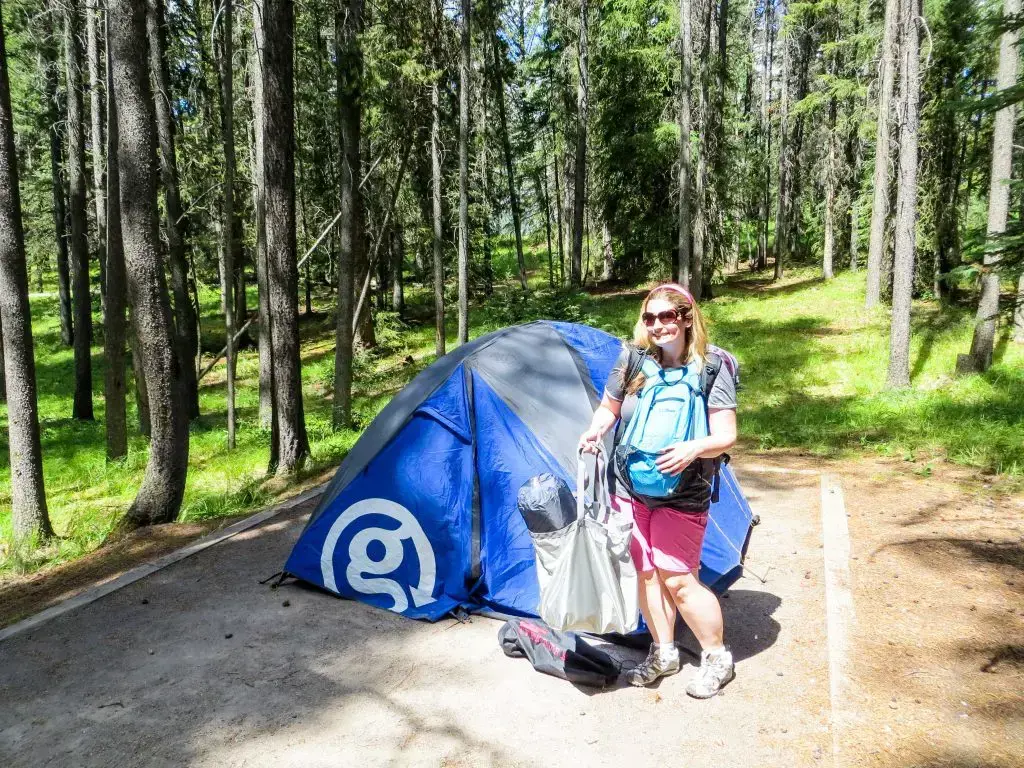
If you're planning a trip to Banff National Park in Canada, you're in for a treat! Banff offers some of the most breathtaking scenery in the world, with mountains, lakes, and forests to explore. However, before heading out into the wilderness, it's important to make sure you're properly prepared. Here's a list of essential items to pack for hiking or camping in Banff:
- Clothing: Banff's weather can be unpredictable, so it's important to dress in layers. Start with a moisture-wicking base layer to keep you dry and comfortable. Next, add an insulating layer, such as a fleece or down jacket, to keep you warm. Finally, pack a waterproof and windproof outer layer to protect you from the elements. Don't forget to pack hats, gloves, and extra socks as well.
- Footwear: A sturdy pair of hiking boots is a must for exploring Banff's trails. Look for boots that provide ankle support and have a good grip on the soles. Make sure to break in your boots before your trip to avoid blisters. Additionally, pack a pair of comfortable walking shoes or sandals for relaxing at the campsite.
- Camping Gear: If you plan on camping in Banff, you'll need to bring a tent, sleeping bag, and sleeping pad. Choose a tent that's lightweight and easy to set up, and make sure your sleeping bag is rated for the temperatures you'll be experiencing. A sleeping pad will provide extra comfort and insulation from the cold ground. Don't forget other essentials like a camping stove, cookware, and a water filter.
- Backpack: A comfortable and durable backpack is essential for carrying all your gear. Look for a backpack with adjustable straps and multiple compartments to keep your belongings organized. Make sure your backpack fits properly and distribute the weight evenly to avoid strain or discomfort.
- Navigation and Safety: Banff offers a vast network of trails, so it's important to have the right tools for navigation. Pack a map and compass, and consider bringing a GPS device or a smartphone with offline maps. It's also crucial to carry a first aid kit, emergency whistle, headlamp, and a multi-tool. Familiarize yourself with basic first aid skills and wilderness safety protocols.
- Food and Water: While there are food and water sources available in Banff, it's always a good idea to bring some of your own supplies. Pack lightweight, non-perishable foods that are easy to prepare. Granola bars, trail mix, and freeze-dried meals are all good options. Remember to bring a water bottle or hydration bladder, and consider bringing a water purification system in case you need to refill from streams or lakes.
- Other Essentials: Don't forget to pack sunscreen, insect repellent, and a hat to protect yourself from the sun and bugs. It's also a good idea to bring a lightweight and packable camping chair for relaxing at the campsite. Additionally, pack toiletries, a towel, and any medications or personal items you may need.
By packing these essential items, you'll be well-prepared for your hiking or camping adventure in Banff. Remember to plan your trip ahead of time, check weather forecasts, and let someone know your itinerary before heading out. Enjoy the beauty of Banff and stay safe!
The Ultimate Packing Checklist for Your Trip to Fiji
You may want to see also

Are there any restrictions or guidelines for packing certain items when traveling to Banff?
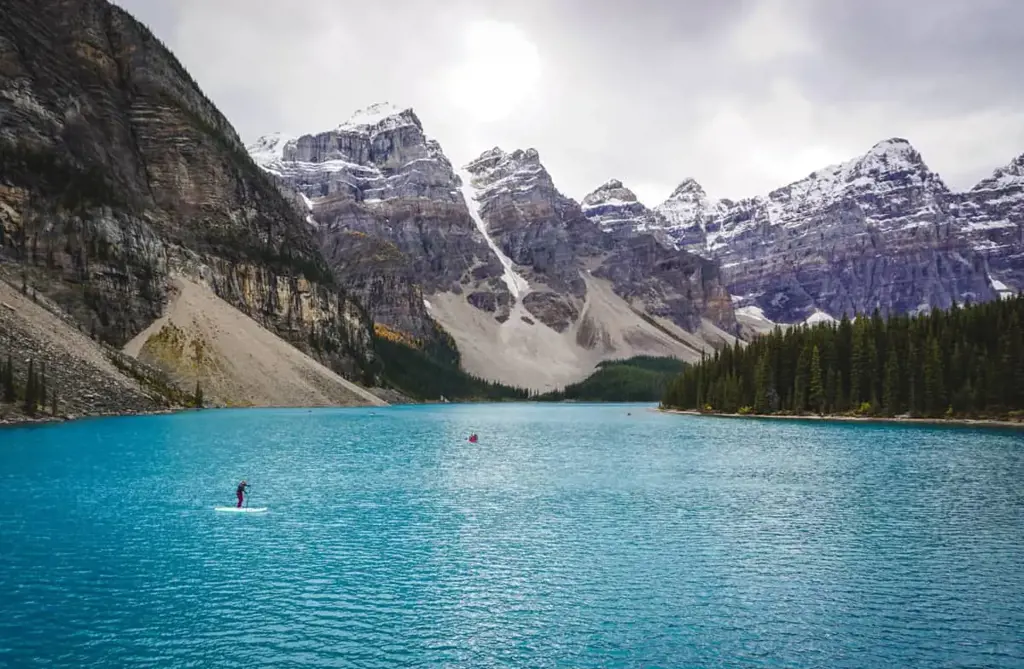
When planning a trip to Banff, it is important to consider the restrictions and guidelines for packing certain items in order to ensure a smooth and hassle-free travel experience. Whether you're a seasoned traveler or a first-time visitor, it's worth knowing what you can and cannot pack, as well as any specific rules or regulations that may apply.
One of the most important things to keep in mind when packing for Banff is the climate and terrain. Banff is located in the Canadian Rockies, which means you can expect a variety of weather conditions throughout the year. From hot summers to snowy winters, it's crucial to pack clothing and gear appropriate for the season.
In the summer months, when temperatures can rise to around 70°F (21°C), it is advisable to pack lightweight and breathable clothing such as t-shirts, shorts, and sunglasses. Additionally, it is important to bring a jacket or sweater, as the temperature can drop significantly during the evenings. If you plan on hiking or participating in outdoor activities, it is essential to pack sturdy, comfortable footwear, sunscreen, insect repellent, and a hat for sun protection.
During the winter months, temperatures in Banff can drop to below freezing, with an average of -8°F (-22°C) in January. Packing warm clothing such as thermals, sweaters, hats, gloves, and a heavy winter coat is essential. It is also advisable to bring waterproof and insulated boots to navigate the snowy terrain. If you plan on participating in winter sports such as skiing or snowboarding, it is important to pack appropriate gear such as helmets, goggles, and ski attire.
In addition to packing for the climate, there are also restrictions and guidelines for certain items when traveling to Banff. It is important to be aware of these regulations to avoid any issues when going through airport security or crossing the Canadian border.
Firstly, it is important to note that Canada has strict regulations on the importation of firearms and other weapons. It is essential to check with the Canadian Border Services Agency for the most up-to-date information on what is allowed and what is prohibited. It is also important to declare any firearms or weapons you may be carrying when entering Canada.
Another important consideration is the restrictions on bringing food and agricultural products into Canada. Many fruits, vegetables, meats, and other products are regulated to prevent the introduction of pests and diseases. It is advisable to check the Canadian Food Inspection Agency website for a list of prohibited items to avoid any issues with customs.
When packing toiletries and other personal items, it is important to abide by the carry-on liquid restrictions set by the Canadian Air Transport Security Authority. All liquids, gels, and aerosols must be in containers of 100 milliliters (3.4 ounces) or less and must fit into one clear, resealable plastic bag.
In conclusion, when traveling to Banff, it is crucial to consider the restrictions and guidelines for packing certain items. Packing clothing and gear appropriate for the climate and terrain is essential for a comfortable and enjoyable trip. Additionally, it is important to be aware of the regulations regarding firearms, food, and carry-on liquids to avoid any issues with customs and airport security. By following these guidelines, you can ensure a smooth and hassle-free travel experience to Banff.
Essential Items to Pack for a Caribbean Cruise in February
You may want to see also
Frequently asked questions
When packing for a trip to Banff, it's important to be prepared for a variety of weather conditions. In the summer, temperatures can range from cool mornings to warm afternoons, so packing layers is essential. Be sure to bring a mix of short-sleeve and long-sleeve shirts, lightweight pants or shorts, and a light jacket or sweater for cooler evenings. Don't forget to pack comfortable hiking shoes or sneakers, as well as a hat and sunglasses for sun protection. In the winter, temperatures can drop below freezing, so it's important to pack warm layers, including a heavy coat, thermal base layers, gloves, a hat, and warm socks. Additionally, if you plan on participating in outdoor activities such as hiking or skiing, be sure to pack appropriate gear and equipment.
If you plan on partaking in outdoor activities during your trip to Banff, there are a few specific items you should pack. First and foremost, a sturdy backpack is essential for carrying all of your gear and supplies. It's also important to pack a reusable water bottle to stay hydrated, as well as snacks for energy while on the go. Depending on the activity, you may also need to pack a compass, map, and/or GPS device for navigation purposes. It's also a good idea to bring a first aid kit, sunscreen, bug spray, and a camera to capture the beautiful scenery.
A visit to the Banff hot springs is a popular activity for many visitors. When packing for a trip to the hot springs, it's important to bring a swimsuit and a towel. Some people also like to bring a robe or cover-up to wear while walking around the facility, as well as flip flops or sandals for easy access to the pools. It's also a good idea to pack a waterproof bag or container for storing valuables while in the water. Additionally, don't forget to bring any necessary toiletries, such as shampoo, conditioner, and soap, as well as a change of clothes for after your soak.







